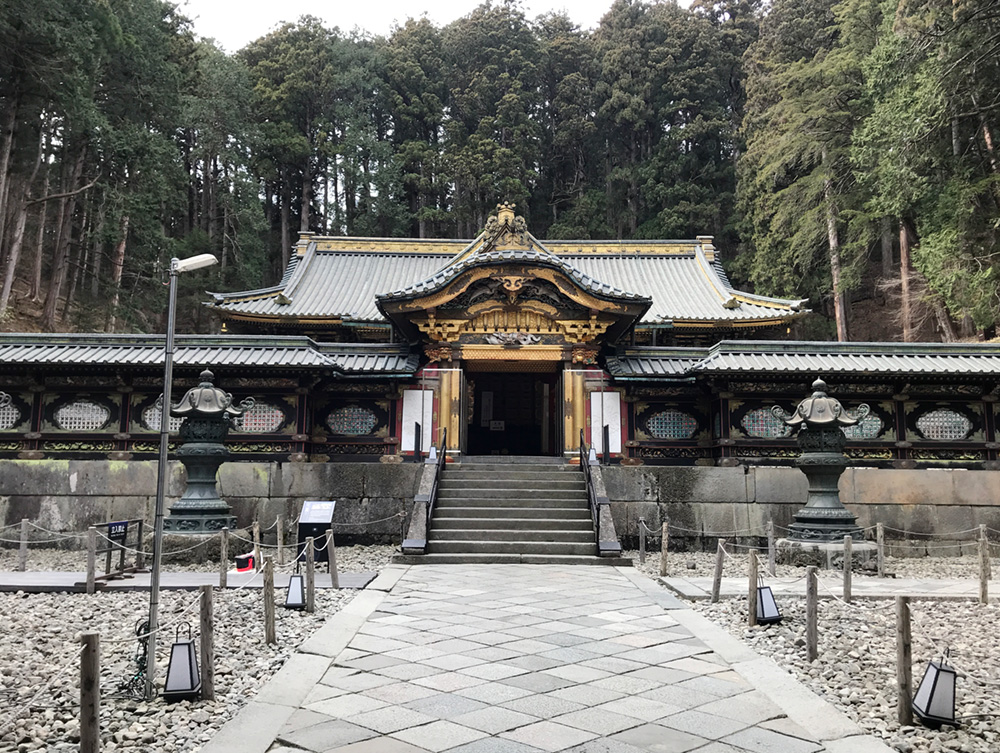唐門
Karamon Chinese Gate
唐门
唐門
가라몬, 중국문
Porte chinoise Karamon
Karamon, Chinesisches Tor
Puerta china Karamon
ประตูแบบจีน คารามง (Karamon)

唐門とは、中国風の門という意味です。総金箔造りで、軒下には丹頂鶴、白龍が、玉垣には、たくさんの鳩、左右の壁には秋の七草が、彫刻されています。
門前にある左右の大きな灯籠は、徳川御三家(紀州・水戸・尾張)からの献上品です。
In contrast to the three previous gates, the Karamon is smaller in scale, and its carvings are very different from the fierce guardians displayed on the other gates. Above the entryway are a pair of dragons and a pair of cranes. Iemitsu was born in the year of the dragon, and the cranes symbolize long life. One hundred pigeons are carved along the wainscoting of the gate. The pigeon is associated with the god of warriors, Hachiman, and is symbolic of the Tokugawa house’s martial roots. These features combined together indicate that the visitor has passed from the dangers of the world below into the world above.
Chinese gates are defined by the karahafu Chinese gable over the entranceway, which has a rounded shape rather like the form of a recurve bow. The karahafu indicates high rank and was reserved for gates used by people of high rank, hence its utilization at the entrance to the main hall of Iemitsu’s mausoleum. The gate is called the Chinese Gate because it is based on Chinese architectural styles. However, as in the case of the Gate of the Yasha, this is actually a Japanese interpretation of a Chinese style.
与之前的三道大门相反,唐门的规模较小,其上的雕刻与其他大门上呈现的凶悍守护神有很大不同。入口上方是一对龙和一对鹤。德川家光生于龙年,而鹤象征着长寿。沿大门的护墙板上雕刻着一百只鸽子。鸽子与武神八幡神有关,象征着德川家的武学渊源。这些形象一同暗示着游客已经穿过凡间的危险抵达上方的世界。
唐门因入口上方的唐破风中式山墙而更显清晰,山墙呈圆形,颇像一把反曲弓。唐破风暗示着地位较高,专用于地位较高的人家的大门,因此被用于德川家光陵墓正殿的入口处。这道门被称为唐门,是因为它基于中国的建筑风格所建。但是,与“夜叉门”一样,这实际上是对中国风的一种日式演绎。
與之前的三道大門相反,唐門的規模較小,其上的雕刻與其他大門上呈現的兇悍守護神有很大不同。入口上方是一對龍和一對鶴。德川家光生於龍年,而鶴象徵著長壽。沿大門的護牆板上雕刻著一百隻鴿子。鴿子與武神八幡神有關,象徵著德川家的武學淵源。這些形象一同暗示著遊客已經穿過凡間的危險抵達上方的世界。
唐門因入口上方的唐破風中式山牆而更顯清晰,山牆呈圓形,頗像一把反曲弓。唐破風暗示著地位較高,專用於地位較高的人家的大門,因此被用於德川家光陵墓正殿的入口處。這道門被稱為唐門,是因為它基於中國的建築風格所建。但是,與“夜叉門”一樣,這實際上是對中國風的一種日式演繹。
이전 세 개의 문과 달리 가라몬은 규모가 더 작고, 조각도 다른 문에 있는 험상궂은 수호자와는 아주 다릅니다. 입구 위에는 용과 학이 각각 쌍을 이루고 있습니다. 이에미츠는 용의 해에 태어났고, 학은 장수를 상징합니다. 100마리의 비둘기가 문을 따라 새겨져 있습니다. 비둘기는 신의 전사인 하치만과 관련이 있고, 도쿠가와 가문의 무사로서의 뿌리를 상징합니다. 이러한 특징이 결합되어 방문객이 아래쪽 세계의 위험에서 벗어나 위쪽 세계로 이동했음을 나타냅니다.
중국문은 현관 위 당파풍의 중국 박공이 특징인데, 둥근 모양으로 구부러진 활과 같은 형태입니다. 당파풍은 높은 지위를 나타내며, 이들이 사용하는 문으로 여겨지므로 이에미츠 묘의 본당 입구에 사용되었습니다. 중국 건축 양식을 기반으로 하여 중국문이라 불립니다. 그러나 야사몬과 마찬가지로 중국 양식을 일본식으로 해석한 것입니다.
Contrairement aux trois portes précédentes, la porte Karamon est de plus petite taille et ses sculptures sont très différentes des féroces gardiens affichés sur les autres portes. Au-dessus de l'entrée se trouvent un couple de dragons et de grues. Iemitsu est né l'année du dragon et les grues symbolisent la longue vie. Cent pigeons sont sculptés le long du lambris de la porte. Le pigeon est associé au dieu des guerriers, Hachiman, et est symbolique des racines martiales de la maison Tokugawa. Ces caractéristiques combinées indiquent que le visiteur est passé des dangers du monde d'en bas au monde d'en haut.
Les portes chinoises sont définies par le pignon chinois karahafu au-dessus de l'entrée, qui a une forme arrondie un peu comme la forme d'un arc classique. Le karahafu indique un rang élevé et était réservé aux portes utilisées par des personnes d’un tel rang, d'où son utilisation à l'entrée du hall principal du mausolée d’Iemitsu. La porte est appelée la porte chinoise car elle est basée sur les styles architecturaux chinois. Cependant, comme dans le cas de la Porte Yashamon, il s'agit en fait d'une interprétation japonaise d'un style chinois.
Im Gegensatz zu den drei vorherigen Toren ist das Karamon kleiner und die Schnitzereien unterscheiden sich stark von den grimmigen Wächtern, die auf den anderen Toren zu sehen sind. Über dem Eingang befinden sich ein Drachen- und ein Kranichpaar. Iemitsu wurde im Jahr des Drachen geboren und die Kraniche symbolisieren ein langes Leben. Einhundert Tauben sind entlang der Verkleidung des Tores geschnitzt. Die Taube steht in Verbindung zur Kriegsgottheit Hachiman und symbolisiert die kriegerischen Wurzeln des Hauses Tokugawa. Diese Merkmale zusammen deuten an, dass der Besucher den Gefahren der Unterwelt entkommen ist und sich nun in der Oberwelt befindet
Chinesische Tore erkennt man an den chinesischen Karahafu-Giebeln über dem Eingang, die eine abgerundete Form haben und einem Recurvebogen ähneln. Das Karahafu indiziert einen hohen Rang und wurde daher an Toren angebracht, die von Personen hohen Ranges genutzt wurden – daher die Verwendung am Eingang der Haupthalle von Iemitsus Mausoleum. Das Tor wird als chinesisches Tor bezeichnet, da es nach chinesischem Baustil errichtet wurde. Wie im Fall des Yasha-Tores, ist dies jedoch eine japanische Interpretation des chinesischen Stils.
En contraste con las tres puertas anteriores, la Karamon es de menor escala y sus tallas son muy diferentes de los feroces guardianes que se muestran en las otras puertas. Sobre la entrada hay un par de dragones y un par de grullas. Iemitsu nació en el año del dragón y las grullas simbolizan una larga vida. A lo largo del revestimiento de la puerta, hay cien palomas talladas. La paloma se asocia con el dios de los guerreros, Hachiman, y es un símbolo de las raíces marciales de la casa Tokugawa. Estas características combinadas indican que el visitante ha superado los peligros del mundo terrenal para llegar al mundo celestial.
Las puertas chinas se caracterizan por el aguilón chino, o karahafu, que tienen sobre la entrada, cuya forma redondeada recuerda a la de un arco recurvo. El karahafu indica alto rango y se reservaba para las puertas que usaban las personas de dicha posición; de ahí su utilización en la entrada al Pabellón Principal del mausoleo de Iemitsu. La puerta lleva el apelativo china porque se basa en los estilos arquitectónicos chinos. Sin embargo, como en el caso de la Puerta de los Yasha, su estilo es en realidad una interpretación japonesa del estilo chino.
ตรงกันข้ามกับประตูทั้งสามก่อนหน้านี้ คารามง (Karamon) มีขนาดเล็กกว่า และรูปแกะสลักก็แตกต่างไปจากเทพผู้พิทักษ์ที่ดุดันที่อยู่ที่ประตูอื่น ด้านบนทางเข้ามีมังกรหนึ่งคู่และนกกระเรียนหนึ่งคู่ อิเอมิตสึ (Iemitsu) เกิดในปีมะโรง และนกกระเรียนเป็นสัญลักษณ์ของชีวิตที่ยืนยาว มีการแกะสลักนกพิราบหนึ่งร้อยตัวตามแนวแผ่นไม้บุผนังประตู นกพิราบมีความเกี่ยวข้องกับเทพเจ้าแห่งนักรบฮาจิมัน (Hachiman) และเป็นสัญลักษณ์แห่งฐานกำลังทางทหารของตระกูลโทกูงาวะ คุณลักษณะเหล่านี้รวมเข้าด้วยกัน แสดงบ่งชี้ว่าผู้มาเยือนได้ผ่านพ้นจากอันตรายของโลกเบื้องล่างเข้าสู่โลกเบื้องบนแล้ว
ประตูแบบจีนถูกนิยามจากหลังคาหน้าจั่วแบบจีนคาราฮาฟุ (Karahafu) ที่อยู่เหนือทางเข้า ซึ่งมีรูปทรงโค้งมนคล้ายกับคันธนูรูปโค้ง คาราฮาฟุบ่งชี้ถึงยศในระดับสูงและถูกสงวนไว้เป็นประตูที่ถูกใช้สำหรับบุคคลที่มียศสูง ดังนั้นจึงถูกใช้ประโยชน์ที่ทางเข้าวิหารหลักของสุสานอิเอมิตสึ ประตูถูกเรียกว่าประตูแบบจีน เนื่องจากเป็นไปตามรูปแบบสถาปัตยกรรมจีน อย่างไรก็ตาม ในกรณีของประตูแห่งยาชะ (Yasha) ซึ่งอันที่จริงแล้วเป็นรูปแบบจีนที่ถูกตีความในแบบญี่ปุ่น
